Originally presented by Andy Crestodina, OrbitMedia Studios at Insights Marketing Day 2022
I'm glad to be sharing this information that I believe is very important. I'm going to put together all of my favorite tactics, all the things that I've learned. 18 years in digital, 18 years in SEO and analytics. We're going to combine it all into a statistically stronger strategy than most. The strategy that statistically combines the things that are not very common, and when you put them together, you're going to have a 1% strategy. These are some of my favorite things.
Create original content
First, I want to explain really how content works to drive demand. If you read a HubSpot Blog or these popular marketing blogs, they make it sound like, "Just write something, and visitors will read that article. They'll find it from search, from social, from email. They may take an action by subscribing, following, or linking. And magically, some percentage of these people who read your article will just suddenly need your services. They’ll move from the service page to the about page to the contact page, fill out the form and become a lead.”
In my experience, the percentage of people who read articles and then become a lead is a very small amount. For example, There are 1.3 million visitors to a particular blog, however, there are only .03% of people who start on a blog post who actually become a lead. Why? Because they don't have commercial intent. They only have information intent. Now, if you examine people who start their visit on a service page, you see that 1.58% of people become leads from a service page. You're 50 times more likely to turn that person into a lead if you can get them to start their visit at a sales page, a service page, a product page, on your programs.
Mechanism for Demand
Not only is it weird for people who start at an article to become a lead, it's weird for people to link to one of your sales pages. Why would someone link to that? This is the mechanism for demand. Those blog posts give the universe something to link to. They attract links from other websites. Those links and authority make all of your website more likely to rank. That's how you attract lots of blog readers. This is how a service page is going to rank and attract a qualified visitor, a visitor 50 times more likely to become a lead, who then reads your about page, your contact page, fills out a contact form, and becomes demand. This is one of the biggest benefits of content marketing, to publish something that makes your site more authoritative because it gives the world something to link to. Now you've got a chance of ranking.
Increasing Interactions
Its common for people to constantly publish more and more stuff everyday and most content gets no results at all. Yet a tiny percentage of accounts get all the views. A tiny percentage of YouTubers - basically, it's like the 1% right? How do we be that strategy? It’s not “good content is good, and bad content is bad.” It's “good content is amazing and bad content is literally worthless.” Like it gets no result at all. Not exaggerating. Steve Rayson did a study of a million articles and found that 75% of articles nobody ever links to. Further, 50% of articles get two or fewer Facebook interactions. We’ll call that zero with results in social- that's basically a blogger and their editor. It’s like me and my mom. Nobody. Round that down to zero because that's almost no interaction at all.
Yet tiny percentage get ridiculous results, get huge engagements, get tons of ranking and attract piles of links. What's working? If you want to create content that achieves a high level of both shares and links, call it social and search, and you should concentrate on two things:
1. Opinion from the authoritative content
2. Well researched and evidence to content
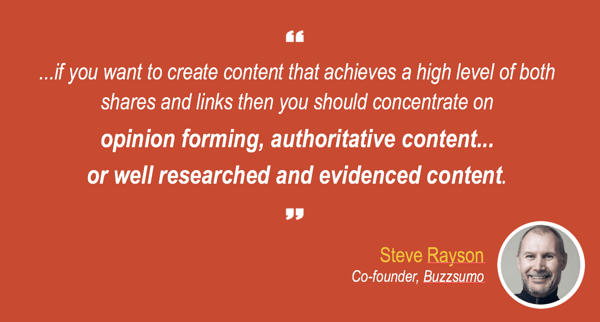
Original Research
The research is the stuff that attracts the links. Why? Because it makes you the primary source. Is your website the primary source for any information in the world? If not, you've got a big challenge! It's very hard to attract the links that are going to help you rank for the money phrase. I want to talk about two examples of this.
Example one: What's the lifespan of a website? What's lifespan of a website? Anyone know? No one knows. Couldn't find that information on the internet - I got an idea. I download a list of the top 50 marketing websites. I email that list to a virtual assistant and she went through and looked at every one of those websites in the Wayback Machine. You know, archive.org - you can see early versions websites, to see the interval at which these sites redesign. The post is called "What's The Average Website Lifespan? 10 Factors in Website Life Expectancy.” The answer is 2 years and 7 months. That information did not exist on the internet prior to me publishing this URL. Wikipedia now links to my article.
Example two: What website features are standard? I don't know, good question. What features are standard? The same list of 50 websites, email it back to the same virtual assistant gave her a spreadsheet with a row for each different website feature and publish this article. I came up with a list of web design standard. If 75% of websites or more had it, I called it a standard. It’s my own rule. I made it up. We’re going with it. 50% or more, I called it a web convention. These are the features that are standard for websites. That article ranks number two today for web design standards. My point being is that, that's an indication of quality. That articles gotten lots of visibility over time, hundred thousand plus views over time. It's attracted 227 links, because it is a primary source of information on the internet. This information does not exist other places. What features are standard to websites? That's the best answer on the internet. My goal may be the best answer on the internet for whatever the topic was.
This is a super credible domain because of research like this. Cost? It didn't cost me anything. It wasn't an expense. It was just time. Of course, time is an expense, but…I’m a half time marketer. I have one full time marketer. One and a half marketers, we generate 1.4 million visitors a year, 1000 qualified visit leads a year without any real out of pocket expenses for any kind of advertising through programs like this. Could you replicate that? Absolutely.
What do people in your industry frequently say but rarely support with evidence? That's all we're doing. What is the frequently asserted, but rarely supported statement in your field? Find, conduct the research, published the missing statistic in your field. Some missing statistics, by the way, support a sales message. We design websites. By the way, your website is older than the average website. How do I know that? I found out the average lifespan of a website. So, find the missing stat: Killer marketing. It's going to put your head and shoulders above the rest.
Collaborate with influencers
Second tactic is to collaborate with influencers. I'll break it down again, we want a lead. To get a lead, you need two things: Total number of visitors and the percentage of visitors who take action. We need traffic. There's three sources of traffic and content marketing: search, social and email. But we know that search is the more powerful source of traffic because that visitor has intent. They just typed it into a keyboard, while visitors and search in social and email or more likely touching glass or mouse. They have intent the more likely to become a lead.
Two main search ranking factors: links and authority, we just talked about, and content relevance. Why do people link to things? Really important question, why do people link to things? The answer is because you've got something worth linking to. We just broke that down with original research. Further, you've got relationships with people who create content. They're called influencers. That's the original research. And we're going to collaborate with content marketers, I'm going to reverse engineer demand and create tons of authority and links that aren't my competitors.
There's three main types of collaboration. There's the contributor quote, there's the expert roundup, and there's the deep dive interview. I make sure to include contributor quotes in almost everything I write. A journalist would never write an article without including a source. Why would the content marketer ever write an article without including a contributor quote? A bunch of good things happen: It makes your content higher quality, you got an expert point of view, and it makes your content reach farther, because now you've got someone who is likely to share it. When you included someone with a social following; you're going to grow your network, which we just heard is very valuable. It's good to network, content is an act of networking when done properly. It's more fun.
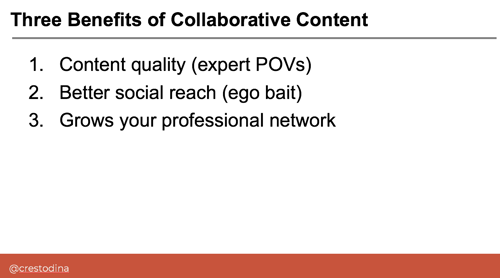
Content optimize for social includes people. There should be faces and names and job titles and companies. It is very hard to get traction on an article that doesn't have other points of view in it. Right? How credible is that? It's very hard to do. But there's other tactics by the way, there's other ways to do content. The daily blogger, my survey shows, those people are crushing it. They're more than twice as likely to report strong results from digital.
My blog is awesome for me. I learned a lot from it. I learned a lot from the articles that I write. Because I talked to experts as I write to learn from them to make my content better, right?
You're not asking for a link. We're hoping that happens organically by writing super high quality stuff and making it visible to content creators. But John Rampton (https://www.johnrampton.com/), who's a big time influencer and columnist says, one in 10 people that you help will help you back. You're basically giving what you're hoping to get. I never asked for a link. I’m just including people in this content. And sure some people who I included in, tend to link back to it. If you want followers, follow people. If you want comments, write comments on things. If you want LinkedIn recommendations, write LinkedIn recommendations for people. You're going to get what you give. And this is kind of the math in his mind, I actually believe even this last part. One in 100 people you help, will turn into a financial relationship - could become a lead. One in 10,000 people you help, will turn into a multimillion dollar relationship - I can actually give you lots of examples of those people.
Publish everywhere
There is a big difference between a bloggers who don't collaborate and those who do. For the bloggers who do collaborate with editors and their content team, their articles are going to get linked back to their content in the author bio or editorial. Now this person has more content associated with their brand. Right? They got more networks, they got a link from another sites. The only difference that makes a difference is a collaborative mindset. They just think about it differently. They're not just writing for themselves, they’re not the only person writing for them. Not just writing on their own site. They're writing all over the place. So everybody does it right? Nope. Only 65% of bloggers report writing ever, ever report writing for any other website, two-thirds at most, I think a lot of people don't do it.
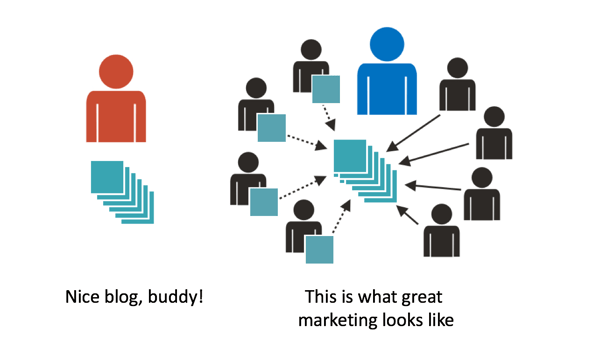
To this day, a third of the content I create is written for other people's websites. Why wouldn't I do that? Whose brand is too big to ever want to be in front of a larger audience? I will never stop doing this- very important.
Update old content
My fourth tactic, we're going to go back and update older content. This is specific to SEO. This is the analytics performance of a single piece of content. The article goes live, and you get a spike in email, social, shares from collaborators, and your engaging in comments. Its not all about getting this long tail of traffic for weeks or days, months, years later it's about getting your content to be keyword focused, then it ranks in searches. Once you realize this, you know it's more valuable to update, improve, refresh, and sharpen the keyword focus on these pages that are already performing well than to write an entirely new article. It’s a far faster way to get better results than starting from scratch.
How do you know which content is performing well? You use data analytics to see which pieces of content have the most traffic and how phrases rank. Some of the programs I use are Google Search Console Analytic, Buzzsumo, and Moz. These tools help keep track of every phrase you rank for, how high you rank for that phrase, track ranking, and how much traffic you have on each page, and multiple other tools. These tools allow you to see which pages are getting more traffic over the other pages. In knowing this information you can go back and defend your traffic magnets using that exact tactic, because some of your pages are getting more traffic than your average page.
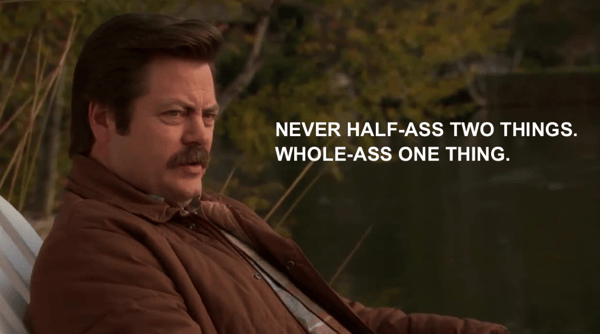
You can defend those traffic magnets because that's your best cheese. By using Moz I can track my ranking and when the traffic starts to go down, it's like a light goes off. It's like a warning sign. I need to defend this guy because he's starting to lose, been out there for a long time, new content is coming out on this topic. It's no longer the best page on the internet for the topic. It has lots of authority, 179 websites that link to that, half the battle is already won, two search ranking factors authority and relevance, it already has strong authority. I just need to give it a little bit better relevance. If your page doesn't rank, maybe it's because you only wrote at once. Go back and write it again, keep rewriting it, keep working on it.
This changed everything for me when I read this quote at the bottom of an obscure interview with this super famous SEO, it's at the end of the long conversation he said this. I'll paraphrase:
“Only if all of my content is up-to-date, ranking where I think it should be, will I write a new article. If not, I go update, rewrite, relaunch an older post.”
That’s a different way to think about it.
My goal should be the goal of any SEO to literally make the best page on the internet for that topic. This is the not the daily blogger strategy. This is the SEO, deep content strategy. Literally, I'm trying to make the best page on the internet for my topic in every case. The article today ranked number one for web design tips. It was getting a couple hundred visitors a month. Now it's getting a couple hundred visitors... No, now is getting a couple of thousand visitors a month. If I get on my phone to check analytics, there are likely visitors on that page right now. It's attracted 148 links.
 Maybe you don't need 1000 articles. Maybe you just need like 100 really good articles. Those deep pieces that answer important questions for your audience. Can you make 100 of the best things, do way better than 1000 good things? But when you do that there's a trick. Do not change the URL, because if I change that URL, I'm going to go break the links on the internet. You’ve got to keep the URL. It’s going to build the credibility to that URL to make it more and more authoritative over time. And then I finally realized, like after 10 years, I figured this one out. You should never put a number in a URL – we had a 9. Because when I go rewrite this and it becomes 11 best practices, there's a mismatch right between the URL and the H1 header. The URL should just have short Simple English, readable, keyword-focused, with no numbers and no formats.
Maybe you don't need 1000 articles. Maybe you just need like 100 really good articles. Those deep pieces that answer important questions for your audience. Can you make 100 of the best things, do way better than 1000 good things? But when you do that there's a trick. Do not change the URL, because if I change that URL, I'm going to go break the links on the internet. You’ve got to keep the URL. It’s going to build the credibility to that URL to make it more and more authoritative over time. And then I finally realized, like after 10 years, I figured this one out. You should never put a number in a URL – we had a 9. Because when I go rewrite this and it becomes 11 best practices, there's a mismatch right between the URL and the H1 header. The URL should just have short Simple English, readable, keyword-focused, with no numbers and no formats.
Upgrading visual formats
When to upgrade the visual formats - Here's the guaranteed success formula. Your top blog post as an infographic will definitely perform well. It's a vetted topic, can even go back to BuzzSumo and see who shared the original blog post, and then make those exact people aware of the new infographic. This tool will show you who shared the old URL. Make it a video- put that video at the top of that blog post, same URL.
Therefore, you could argue this is the purpose of analytics is to help you find those out-performers. Updating and repurposing, high performing content is greater value to your brand than writing a new article. That's the thesis here, creating videos, images, a visual content is going to be greater value than writing new articles. Writing more articles, though, is definitely a better action than email. Small part of you dies as soon as you open your inbox every day. Write an article before you open your inbox.
If you produce original research, especially, if you put diagrams into your content, you have a magical SEO link building opportunity. Because if somebody asks you to contribute to something else, which is now likely because you've been including them in your content. I look in Moz, see what the value of that link would be. Then I look at my list of things on my radar to see which of my articles needs a little love. I am Immediately building a link opportunity to this article that needed the link to the most. But how can I get that link to that article into my contribution? The answer is with an image. Because if your articles include images in them, when you contribute to other people's content, you're going to get an opportunity to add an image source link back to your content. Editors remove links all the time, right? And the SEOs always complain like, "Ah, they took out my link!" The link didn't really need to be there. But this link almost never gets removed because it's a citation. Very hard to rank content if it doesn't have that diagram in it, because that diagram can be used in contributor quotes in other people's content.
Blog written by Andy Crestodina is a cofounder and the strategic director of Orbit Media Studios, an award-winning web design company, which has completed more than 1,000 successful website projects.

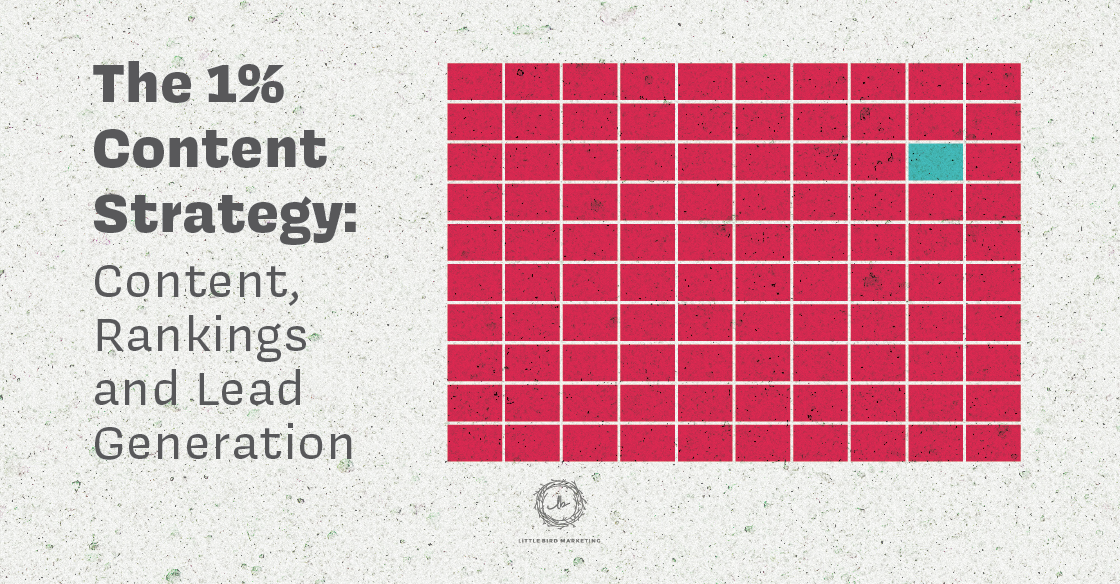
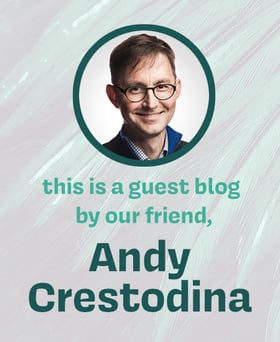



Let Us Know What You Thought about this Post.
Put your Comment Below.